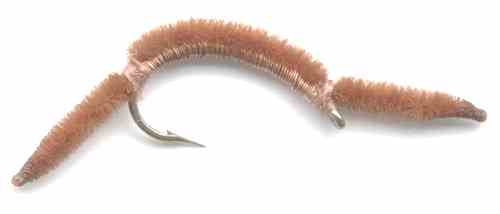The Brown San Juan Worm Fly
San Juan Worms should be in every flybox. Aquatic worms inhabit most waters. They are a very popular fly in Northern California USA.

SAN JUAN WORM FLY PATTERNS. Hook size 10 12 14 16 - $US each
Many fly fisherman scoff at the use of the San Juan because it is not an "insect" imitation. Some people consider this a controversial fly, mostly because it has the word "worm" in its name. It is fished dead drift near the bottom of rivers. The San Juan Worm is a true aquatic earthworm. It averages about two inches in length, and lives in the silty bottom of the San Juan river. Many rivers in the Rockies hold similar species. Fly fishers often imitate this worm with a length of chenille tied to a smaller scud hook.
The San Juan Worm is an excellent pattern to use on Alberta's Bow, Oldman and Crowsnest rivers. Chances are, it will work on your home stream too! It can be fished as a trailing nymph, dead drifted tight to the bottom. Or for midge worms and smaller patterns it can also be fished with a greased leader. Worms occur in dense populations in many silty stream and lake beds. During times of floods, catastrophic drift can expose many worms to waiting trout. During these high water periods a San Juan Worm drifted along the bottom can be deadly. On local rivers "the worm" is a very productive fly during winter months.
If the water is not clear and you cannot see your target fish you will have to read the water to try and find out the best place to cast your fly. Large areas of the river will hold no trout at all. Trout are usually solitary feeders and can normally be found next to something solid like a big boulder, patch of weeds, or the river bank. They lie up in stretches of the river where there is a high concentration of food. Look for creases on the water surface. These are lines that normally run downstream. They are caused by bodies of water, flowing at different rates, colliding. Trout food is concentrated in and around these creases. There is often slack water by the river bank and fast flowing water a few inches away. This is why a lot of trout can be found near the bank. Boulders and weedbeds cause the water to speed up to as they get past them. A crease is formed between the fast and slow water that traps floating aquatic insects in the eddies. Fish the crease and providing the trout are feeding you will catch fish.

